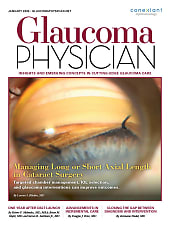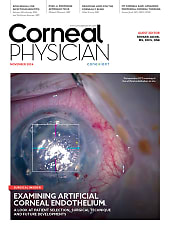Choroidal neovascular membrane (CNVM) secondary to idiopathic intracranial hypertension (IIH; also known as pseudotumor cerebri) is a rare condition that is poorly represented in the literature. One study estimates that approximately 0.5% of patients with IIH will develop CNVM.1 Despite its relative rarity, CNVM must be rapidly diagnosed to prevent irreversible vision loss, particularly if encroachment into the foveal region has occurred. Prompt administration of vascular endothelial growth factor (VEGF) inhibitors is recommended to stabilize the lesion. The following case involves a patient with IIH who presented with progressive vision loss and was found by multimodal imaging to have choroidal neovascular membrane.
CASE REPORT
A 32-year-old female presented with bilateral progressive vision loss accompanied by subjective spots and flashes in both visual fields. Six months prior, bilateral optic disc swelling was noted by her ophthalmologist and she was referred to neurology for further evaluation. Her lumbar puncture opening pressure of cerebrospinal fluid (CSF) was 31 cm H2O (upper limit of normal: 25 cm H2O) and MRI revealed no intracranial mass lesions, suggesting a diagnosis of IIH. Treatment with acetazolamide (2500 mg daily) was initiated. However, she experienced noticeable deterioration in vision, especially in the right eye, during subsequent months. At presentation, her body mass index (BMI) was 35. Medical history was otherwise unremarkable.
On initial evaluation, best-corrected visual acuity (BCVA) was 20/100 in the right eye and 20/25 in the left eye, with right relative afferent pupillary defect (RAPD) noted. Automated perimetry revealed central scotoma in the right eye and full field in the left eye. The fundus imaging of the left eye appeared normal except for stable mild chronic disc edema (Figure 1, A). The right fundus also showed mild optic disc edema, but with a variably pigmented peripapillary lesion with retinal thickening and exudate extending from the disc towards the fovea (Figure 1, B). Optical coherence tomography (OCT) revealed intraretinal fluid (IRF), subretinal fluid (SRF), and distorted outer retinal architecture (Figure 1, C). Fluorescein angiography (FA) of the right eye revealed early hyperfluorescence and late leakage of this lesion (Figure 1, D). Based on these findings, a diagnosis of peripapillary choroidal neovascular membrane secondary to IIH was made.

Two weeks after initial presentation, visual acuity in the right eye had deteriorated to 20/200. Treatment with intraocular bevacizumab (Avastin; Genentech) was initiated, and a total of 9 monthly doses (1.25 mg per dose) were given. Following treatment, stabilization and scarring of the CNVM was seen on fundus examination (Figure 2, A). FA showed no further leakage (Figure 2, B) and OCT showed consolidation of the CNVM into an inactive scar (Figure 2, C). One year after the final bevacizumab injection, fundus examination revealed complete scarring of the CNVM, and VA returned to 20/100. At latest follow-up 5 years after initial presentation, the patient’s optic disc edema had improved with continued use of oral acetazolamide and weight loss, the CNVM remained inactive, and VA in the right eye had improved to 20/80.

DISCUSSION
Since it was first described by Richard R. Jamison in 1978, choroidal neovascular membrane (also known as “subretinal neovascular membrane”) secondary to IIH has been reported in 42 patients (Table 1). Age at presentation has ranged from 13 to 58 years, with women affected more than twice as often as men (30 versus 12 cases, respectively).2,3 The higher prevalence in women is not surprising, as IIH predominantly affects women of childbearing age.4 Studies that reported body mass index indicate that most patients are obese on presentation (BMI ≥30); the largest case series to date reported a mean BMI of 35.5 However, 4 of the 28 studies describing CNVM formation secondary to IIH involved teenage males (age 13 to 15), a population that develops IIH relatively infrequently.2,6-8
| STUDY | PATIENT CHARACTERISTICS | MONOCULAR VS. BINOCULAR | DEFINITIVE TREATMENT | DESCRIBED OUTCOME |
| Nichani et al (2020) | 49, F | Monocular | Bevacizumab (7 doses) | Resolution of CNVM with improvement in Humphrey visual field testing and stabilization of visual acuity |
| Igwe et al (2020) | 18, F | Monocular | Ranibizumab (4 doses) | Involution of CNVM and resorption of subretinal fluid with subretinal fibrosis |
| Ozgonul et al (2019) | 8 F, 2 M(Mean age 34.5) | Monocular (7) Binocular (3) |
Observation (7), bevacizumab (6), ranibizumab (1), aflibercept (1) | All demonstrated regression of CNVM with subretinal fibrosis and visual acuity improved in most patients |
| Kumar et al (2018) | 35, F | Monocular | Ranibizumab (3 doses) | Resolution of hemorrhage with scarring of the CNVM and improvement in visual acuity |
| Scott et al (2017) | 20s*, F | Monocular | Bevacizumab (2 doses) | Resolution of leakage from CNVM with improvement in visual acuity |
| Altan-Yaycioglu et al (2017) | 13, M | Monocular | Ranibizumab (1 dose) | Scarring of CNVM with improvement in visual acuity |
| Hernandez-Ortega et al (2016) | 48, F | Monocular † | Bevacizumab (4 doses) | No improvement in visual acuity |
| Belliveau et al (2013) | 15, M | Monocular | Bevacizumab (6 doses) | Inactive CNVM with improvement in visual acuity |
| Munoz Cardona et al (2013) | 39, F | Monocular | Ranibizumab (1 dose) | Regression of CNVM with improvement in visual acuity |
| Lee et al (2013) | 14, M | Monocular | Bevacizumab (1 dose) | Fibrosis of CNVM, resolution of hemorrhage, and improvement in visual acuity |
| Mas et al (2012) | 31, F | Monocular | Bevacizumab (2 doses) | Resolution of hemorrhage with improvement in visual acuity |
| Kaeser and Borruat (2010) | 14, M | Monocular | Observation | Residual peripapillary fibrotic scar with improvement in visual acuity |
| Aslan et al (2009) | 42, M | Monocular | Observation | Regression of CNVM, resolution of foveal hemorrhage |
| Monteiro et al (2009) | 41, F | Monocular | Bevacizumab (3 doses) | Persistence of CNVM |
| Jamerson et al (2009) | 30, F | Monocular | Bevacizumab (1 dose) | Regression of CNVM with improvement in visual acuity |
| Wendel et al (2006) | 5 F, 1 M(Mean age 46.3)* | Unknown | Observation (3), argon laser coagulation (2), photodynamic therapy (1) | Complete regression of CNVM (3), partial regression with inactivity (2), partial regression with presumed activity (1) |
| Tewari et al (2006) | 27, F | Monocular | Photodynamic therapy and triamcinolone | Resolution of subretinal fluid with improvement in visual acuity |
| Sathornsumetee et al (2006) | 42, M | Monocular | Optic nerve sheath fenestration | Persistence of CNVM with no improvement in visual acuity |
| Nguyen et al (2004) | 39, M | Monocular † | Lumboperitoneal shunt placement | Involution of CNVM with improvement in visual acuity |
| Castellarin et al (1997) | 32, F | Monocular | Surgical excision of CNVM | Atrophy and hypopigmentation at previous level of CNVM, no improvement in visual acuity noted |
| Akova et al (1994) | 33, F | Monocular | Lumboperitoneal shunt placement | Partial membrane regression and fibrosis with permanent vision loss |
| Caballero-Presencia et al (1986) | 39, F | Monocular | Acetazolamide and prednisone | Involution of CNVM, resorption of hemorrhages, and improvement in visual acuity |
| Coppeto and Monteiro (1985) | 58, F | Binocular | Lumboperitoneal shunt placement | Spontaneous regression of CNVM in OS, inactivity and visual acuity improvement in OD |
| Corbett et al (1982) | 38, F | Monocular | Unclear | Permanent visual loss in OD |
| Morse et al (1981) | 32, F | Binocular | Argon laser coagulation (OD only) | Spontaneous involution in OS, fibrosis in OD with resolution of hemorrhage and improvement in visual acuity |
| Morris and Sanders (1980) | 55, F | Monocular | Lumboperitoneal shunt placement | Permanent visual loss in OS |
| Troost et al (1979) | 54, M | Monocular | Observation | Persistence of CNVM, resolution of hemorrhage, with no improvement in visual acuity |
| Jamison (1978) | 31, M | Monocular | Argon laser coagulation | Absence of CNVM with stabilization of visual acuity |
| * Exact age(s) not provided † Patient presented with asymptomatic CNVM in contralateral eye | ||||
Transient visual obscurations are a common finding in IIH and are not characteristic of CNVM. Many of the patients described in prior reports experienced transient vision changes long before the diagnosis of CNVM, in addition to other common IIH-associated symptoms such as headache and dizziness.9 Typically, the CNVM is first identified when the patient presents with sudden, painless, monocular visual loss.9,10 Other visual changes commonly reported by patients with IIH and CNVM include changes in color vision6 and blind spot enlargement.9 RAPD may also be seen on examination.7
Fundus examination reveals typical bilateral changes associated with IIH, including optic disc edema and/or hyperemia as well as obscuration of disc margins.6 Subretinal and/or intraretinal hemorrhages are commonly seen at presentation, and may extend into the foveal region.6 Fundus examination may show IRF or SRF accumulation, neurosensory retinal detachment, and occasionally retinal striae.9,11 The CNVM itself has been described as grey-green and is characterized on FA as hyperfluorescent during the venous phase followed by leakage in the late phase.5 OCT may also reveal IRF or SRF accumulation along with a mixed hyporeflective and hyperreflective choroidal neovascular membrane complex.2
Most reports have described unilateral CNVM, although 7 cases of bilateral CNVM secondary to IIH have been described.3,5,9 The tendency of this condition to develop unilaterally despite diffuse central nervous system involvement and bilateral disc swelling is poorly understood. It has been hypothesized that optic nerve swelling secondary to increased intracranial pressure (ICP) may cause disruption of Bruch’s membrane, which allows vascular invasion from the choriocapillaris.5 This, combined with local hypoxia due to swelling, may promote angiogenesis in the setting of IIH and thus result in neovascular membrane formation.5
Recent success in the treatment of CNVM with VEGF inhibitors supports the hypothesis that hypoxia may play a role in CNVM formation and/or maintenance. VEGF represents an important downstream target of hypoxia inducible factor (HIF),5 and the ability to induce lesion regression using anti-VEGF suggests that local hypoxia may be present in the region of lesion formation. However, it is unlikely that hypoxia alone accounts for the formation and/or maintenance of CNVM secondary to IIH. The exact mechanism of this progression from papilledema to CNVM formation warrants further study. Nevertheless, these findings suggest that an inciting event, such as disruption of Bruch’s membrane, may lead to CNVM development. This may be mediated by VEGF activity, possibly in a hypoxia-dependent manner.
Treatment strategies for CNVM secondary to IIH have evolved over time. The earliest report of this condition from 1978 utilized argon laser photocoagulation,11 and this technique has been used in at least 3 more patients since then.9 In all 4 cases, this approach resulted in complete or partial regression of the lesion with or without improvement in VA, demonstrating its efficacy.
Recently, however, this approach has been replaced by alternative techniques. Other management strategies for CNVM secondary to IIH include observation only,5 lumboperitoneal shunt placement,3 optic nerve sheath fenestration,4 and surgical excision of the lesion.4 These strategies address different aspects of the condition; shunt placement decreases ICP and may decrease optic disc edema, while photodynamic therapy directly treats the site of CNVM.3 Although observation alone can result in favorable visual prognosis in certain patients, there is likely an inherent selection bias whereby those with worse disease receive more aggressive treatment and have poorer visual outcomes. In addition, concurrent efforts to control the intracranial hypertension, usually via oral acetazolamide, are often attempted when tolerated by the patient. Outcomes have varied across patients and treatment modalities, but the most common one has been partial or complete regression of the lesion, with or without improvement in VA (Table 1).
Over the past decade, intravitreal anti-VEGF agents like bevacizumab or ranibizumab have become the standard of care for CNVM; they have been used in 18 of 27 cases described since 2009 with observation alone in all other cases (Table 1). The dosing requirement can range from a single dose2 to a series of 9 monthly doses, as described in this case report. Treatment with anti-VEGF injections has shown efficacy in most patients, with the most frequent outcome being CNVM regression with improvement in visual acuity.2 In some cases, however, the CNVM may not regress at all or patients may not experience an improvement in VA.5 Intravitreal anti-VEGF injections are generally well tolerated, but rare complications can include endophthalmitis, intraocular inflammation, retinal detachment, hemorrhage, and increased intraocular pressure.5 Compared to peripapillary CNVM in IIH, treatment outcomes of peripapillary CNVM in exudative age-related macular degeneration (AMD) demonstrate an average of 2 to 3 injections of bevacizumab necessary to achieve resolution of IRF and SRF on OCT in 85% of patients.11 The current case required 9 monthly injections to achieve inactivity of the CNVM and no additional treatments have been required in long-term follow up of 5 years.
In conclusion, CNVM secondary to IIH is rare, but should be considered in individuals with documented intracranial hypertension who present with sudden, painless, monocular (or rarely, binocular) changes in vision. Multimodal imaging is helpful in the diagnosis of CNVM associated with IIH. Ultimately, anti-VEGF agents such as bevacizumab or ranibizumab represent an appropriate treatment strategy, with CNVM regression and improvement in vision expected to occur in many patients. NRP
REFERENCES
- Wendel L, Lee AG, Boldt HC, Kardon RH, Wall M. Subretinal neovascular membrane in idiopathic intracranial hypertension. Am J Ophthalmol. 2006;141(3):573-574. doi:10.1016/j.ajo.2005.09.030
- Altan-Yaycioglu R, Canan H, Saygi S. Intravitreal ranibizumab injection in peripapillary CNVM related to idiopathic intracranial hypertension. J Pediatr Ophthalmol Strabismus. 2017;54:e27-e30. doi:10.3928/01913913-20170201-04
- Coppeto JR, Monteiro ML. Juxtapapillary subretinal hemorrhages in pseudotumor cerebri. J Clin Neuroophthalmol. 1985;5(1):45-53.
- Chen J, Wall M. Epidemiology and risk factors for idiopathic intracranial hypertension. Int Ophthalmol Clin. 2014;54(1):1-11. doi:10.1097/IIO.0b013e3182aabf11
- Ozgonul C, Moinuddin O, Munie M, et al. Management of peripapillary choroidal neovascular membrane in patients with idiopathic intracranial hypertension. J Neuroophthalmol. 2019;39(4):451-457. doi:10.1097/WNO.0000000000000781
- Belliveau MJ, Xing L, Almeida DR, Gale JS, ten Hove MW. Peripapillary choroidal neovascular membrane in a teenage boy: presenting feature of idiopathic intracranial hypertension and resolution with intravitreal bevacizumab. J Neuroophthalmol. 2013;33(1):48-50. doi:10.1097/WNO.0b013e318281b7b9
- Kaeser PF, Borruat FX. Peripapillary neovascular membrane: a rare cause of acute vision loss in pediatric idiopathic intracranial hypertension. J AAPOS. 2011;15(1):83-86. doi:10.1016/j.jaapos.2010.11.008
- Lee IJ, Maccheron LJ, Kwan AS. Intravitreal bevacizumab in the treatment of peripapillary choroidal neovascular membrane secondary to idiopathic intracranial hypertension. J Neuroophthalmol. 2013;33(2):155-157. doi:10.1097/WNO.0b013e31827c6b49
- Morse PH, Leveille AS, Antel JP, Burch JV. Bilateral juxtapapillary subretinal neovascularization associated with pseudotumor cerebri. Am J Ophthalmol. 1981;91(3):312-317. doi:10.1016/0002-9394(81)90282-8
- Jamerson SC, Arunagiri G, Ellis BD, Leys MJ. Intravitreal bevacizumab for the treatment of choroidal neovascularization secondary to pseudotumor cerebri. Int Ophthalmol. 2009;29(3):183-185. doi:10.1007/s10792-007-9186-y
- Davis AS, Folk JC, Russell SR, et al. Intravitreal bevacizumab for peripapillary choroidal neovascular membranes. Arch Ophthalmol. 2012;130(8):1073-1075. doi:10.1001/archophthalmol.2012.465








